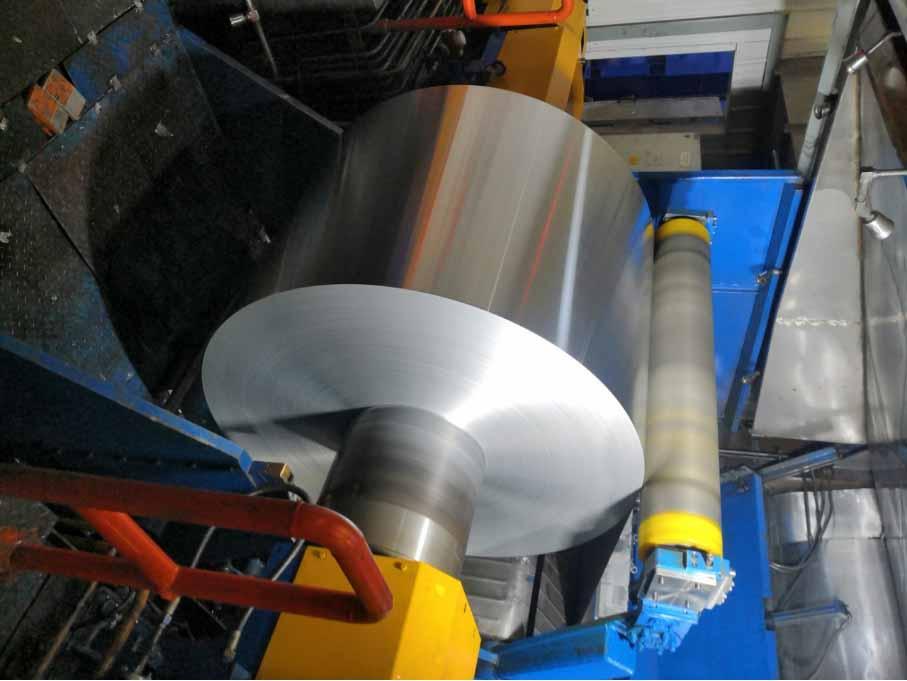Producerea de înaltă calitate 8011 folia de aluminiu presupune un proces de fabricatie precis si controlat. De la selecția materiilor prime până la ambalare, fiecare pas contribuie la performanța și fiabilitatea produsului final. Urmând acestea 8 trepte, 8011 producatorii de folii de aluminiu pot produce 8011 aluminum foil that meets the stringent requirements of various industries, including food packaging, pharmaceuticals, and household applications.

The production process of aluminum foil 8011
Etapa 1: Raw Material Selection and Preparation
To produce high-quality 8011 folie de aluminiu, it is crucial to start with the right raw materials. Select aluminum ingots with a high purity level, de obicei 99.7% or above, ensuring the desired properties in the final product. The ingots are then melted in a furnace to create a molten aluminum bath.
Etapa 2: Turnare continuă
The molten aluminum is poured into a continuous casting machine, where it is solidified into thin slabs. The continuous casting process helps achieve a uniform thickness and ensures the elimination of impurities.
Etapa 3: Laminare la cald
The solidified slabs are reheated and passed through a series of hot rolling mills. The rolling process reduces the thickness of the aluminum, resulting in a coil of semi-finished aluminum foil known as a "hot-rolled coil." The temperature, rolling speed, and reduction rate are carefully controlled to achieve the desired thickness and mechanical properties.
Etapa 4: Laminare la rece
The hot-rolled coil is then subjected to cold rolling, which further reduces the thickness and enhances the surface quality of the aluminum foil. The cold rolling process involves multiple passes through a series of rolling mills, gradually reducing the thickness to the required specifications. Intermediate annealing may be performed between passes to improve the material's formability and remove any residual stresses.

Cold Rolling Of 8011 folie de aluminiu
Etapa 5: Annealing and Final Rolling
After cold rolling, the aluminum foil is annealed to restore its ductility and eliminate any work hardening. The foil is heated to a specific temperature and held for a certain duration, followed by controlled cooling. This annealing process ensures the foil remains flexible and easy to handle during subsequent processing. Once annealed, the foil undergoes final rolling to achieve the desired thickness, smoothness, and uniformity.
Etapa 6: Finishing Processes
After the final rolling, the aluminum foil is subjected to various finishing processes to meet specific requirements. These processes may include trimming the edges, slitting the foil into desired widths, and winding the foil into rolls of suitable lengths.
Etapa 7: Quality Control and Testing
Throughout the production process, strict quality control measures are implemented to ensure the foil meets the required standards. Physical and mechanical tests, such as thickness measurement, tensile strength evaluation, and surface inspection, are conducted to verify the foil's quality and performance.

Quality Control and Testing Of 8011 folie de aluminiu |

Quality Control and Testing of aluminum 8011 folie |
Etapa 8: Packaging and Distribution
Once the 8011 folie de aluminiu passes the quality tests, it is carefully packaged to protect it from damage during transportation and storage. The foil rolls are usually packed in moisture-resistant packaging materials and labeled with relevant information such as specifications, batch number, and manufacturing date. The packaged foil rolls are then distributed to customers and end-users.

Packaging and Distribution of 8011 alloy aluminium foil
